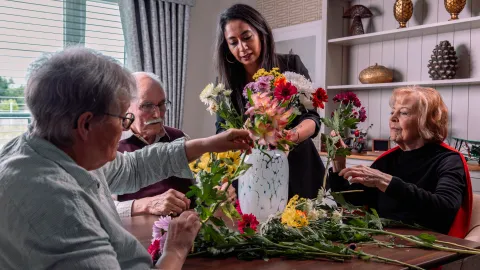How do art and colour influence care homes?
Often when you walk into a room, you simply get a feeling of whether you like it or not. This may be down to the layout, colour or the amount of light, but this initial feeling can have a big impact on how comfortable you feel spending time there.
In care homes, it's important that all these elements are considered to ensure that it works in the way it needs to for the people using it. Of course, this means that you need to have something functional, which allows residents with a variety of mobility needs to get around, and homely so that everyone feels comfortable in the environment.
Colour and art play a key role in care homes. It's important that everyone - residents, staff and visitors - feel welcome and safe in the space. But how does colour help design care homes
Navigation
The colours of doors in the bathroom of our care homes help people with dementia, sight and memory problems to better navigate their way around, encouraging independence and a feeling of belonging. This can also apply to items like furniture, walls and flooring and it's important that these elements stand out enough to be recognised. It's also fairly common to find that handrails, sockets and switches contrast to the colours around them, making it easier for everyone to avoid or use them as necessary.
Feeling at home
It's essential that the colours and art used in an individual's personal space make them feel comfortable. Using art to help residents find their own room door can also be an important part of how care homes are designed.
We ask the resident's family and friends to help them bring some of their favourite objects into their new room to help it feel like home. This is a fantastic way of making residents feel as comfortable as possible from the second they walk through the doors.
Active mind
Art is an important part of our activity sessions at our care homes. From flower arranging to drawing and painting classes to sessions designed to work as therapy, there are a variety of ways our residents can interact with art.
We work with the local community and specialists to find the best ways our care homes can integrate art to empower our residents, regardless of their physical or mental abilities. This can include creating items to fill stalls at events held in our homes or hosting art exhibitions - the possibilities are endless. What's important though is that art can be a powerful tool to help people - of any age - realise their physical and creative potential.
Dress to impress
Often it's not something you think of straight away, but the colours of uniforms worn by staff in care homes is another way that colour can play a key role in elderly care. It's essential that uniforms of all staff are calming and welcoming, which is why you'll often see pastel shades being used and plenty of calming blues and greens.
Dementia care
Colours and art are especially important for people that have been diagnosed with dementia. Not only can they experience memory trouble but their eyesight can also deteriorate as they age. The decor in residents’ rooms and shared areas is carefully considered to ensure people feel at home from the second they arrive, while still providing the support they need.
Because people with dementia often have a real connection with colour, art can be a fantastic way to encourage them to express themselves. As well as the engagement of joining in a class, they can also design pieces for their family or to put up in their own room.
Colour and art at Barchester
Everything matters when you're trying to find the right care home. From the colours of the doors to the amount of green spaces, you need to know that you've found the right care home for you or your loved one. This is why it's important that you get the right support and guidance when it comes to choosing the best home for you or your relative.


